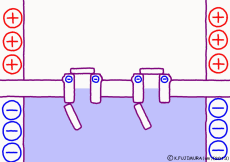[024] Voltage-dependent sodium channel (GB#113A02) | 基礎医学教育研究会(KIKKEN)Lab

★ Please see also the revised version of animation, [055] Voltage-dependent sodium channel [revised].(2017-12-11)
● Ion exclusive access door
In neurons (nerve cells) and muscle cells, ions that are expelled out of the cell are permitted to pass through the cell membrane only for a moment during the action potential. The path through which ions enter and exit is called an ion channel. Since ions can not pass through the lipid bilayer membrane, devices that open and close holes of special protein buried in the lipid bilayer membrane form ion channels. The action potential is a mechanism that spreads the opening and closing of this hole one after another to the surrounding channels.
—
Contents
● Channel chooses ions
There are various kinds of ion channel proteins, but usually they choose ions to pass through. It is called “ion selectivity”. Depending on the type of ion, the size is different so that only the ions that are exactly the size of the hole in the channel can pass well. (Just being perfect is not too big or too small.) Ions that can go through such channels are sodium ions (Na+), potassium ions (K+), calcium ions (Ca2+), chlorine ion (Cl–). It is an ion whose atoms are based (it seems to be a monoatomic ion). Among them, the channel that is the leading role in the action potential is a type that selects and passes only Na + ions and is called a sodium ion channel.
● A channel to open and close by electricity
Furthermore, this channel is a type of channel in which ion paths open and close depending on the electrical state (potential: almost the same as voltage here) placed. Therefore, it is called voltage-dependent sodium channel or voltage-gated sodium channel. When the cell is in a resting state, the inside of the cell is electrically in a constant negative state, and this membrane potential is called a resting membrane potential. Almost all voltage-gated sodium channels are closed in that state, that is, when the inside of the cell is negative and settling. Therefore, sodium ions can not pass through the cell membrane.
The event that the membrane potential approaches zero from the negative state is called depolarization. The sodium channel has the property that the path of ions opens with depolarization above a certain level. And, as soon as it opens, it gets closed by itself.
* It is called “polarization” that it is electrically divided into positive (+) and negative (-). So the fact that the degree of division becomes smaller becomes “depolarization”.
There are also other types of ion channels (ligand-gated channels) that open and close by the binding of small specific substances, and channels due to mechanical force that opens and closes when the cell membranes are distorted.
● Opening gate and closing gate
Aside from the actual structure of the ion channel protein, we usually use the image of the opening and closing of the gate to explain the activity that the ion channel opens or closes. Voltage-dependent sodium channels have both two gates, a gate that opens at depolarization and a gate that closes at depolarization. Listening to that, after depolarization, will the channel open after all? Close? Which one? you may guess. As a channel, it opens only for a moment.

The two gates move differently, and when the cell is in the resting potential, one is closed and the other is open. Because there is a closed gate, the whole channel is closed and ions can not pass. When depolarizing, the closed gate opens. This gate is called an activation gate, it is sensitive to a change in potential, it responds instantaneously to depolarization and lightly opens. On the other hand, the gate that was opened in a stationary state, which is called the inactivation gate, is closed in response to depolarization. However, it is insensitive and slow to move (Please do not ask me why, laugh). So when depolarizing, both the activation gate and the inactivation gate move together, but before the inactivation gate closes, the channel opens a bit with the momentary time difference.
Depolarization means that the polarization is lost and the membrane potential approaches zero. To be precise, the sodium channel reacts when the intracellular potential changes to a positive potential from resting potential, rather than depolarization.
First of all, when the cell starts to depolarize, several channels that are particularly sensitive are opened in myriad of sodium channels. Then, the cell membrane becomes in a state in which sodium ions can pass through a little bit. Because of that, the cell membrane potential is further depolarized slightly (the mechanism of this area is a bit difficult if you do not study a little more ⇒ see, resting membrane potential). As depolarization progresses a bit, the sodium channel that is not yet activated opens. Then it depolarizes further and the channel opens further. Even if the membrane potential passes through zero and reverses to “positive potential”, the ion channel continues to open, and so on. Ambient voltage-dependent ion channels open explosively in chain reaction. Almost all sodium channels are opened, but as each channel closes freely by its inactivation gate immediately, it is only a momentary event that most channels open all at once.
A channel that is once opened and closed does not open in closed state unless the membrane potential returns to its original resting potential. This is because the closed inactivation gate will remain closed in the depolarized state and will not open unless it reverts to the resting membrane potential. Therefore, the action potential which once occurred always returns to the original, and the next action potential can not be generated unless it returns to the origin. Since a new action potential can not be generated while the inactivation gate is closed, this short period is called the “refractory period”. Because there is a refractory period, it will learn that in the textbook “action potential is not weighted”.
● Energy (almost) does not need to open and close the channel
In brief, the mechanism that the gate opens and closes is that the electrical charge in the channel protein changes its position according to the membrane potential, which is used as a switch, the shape of the hole part of the protein is changed and opening and closing. If it is a building automatic door it will consume electricity to open and close. However, since the gate of the voltage-gated ion channel only moves so as to flow according to the surrounding voltage, it does not particularly consume energy for that.
Although it may seem to be using considerable energy to change the membrane potential, the potential actually does not change by the effect of the current, but it switches according to the type of ion that determines the membrane potential, as a result, the positive and negative of the membrane potential is switched. Since ion channels themselves switch this ion, energy change is not used for potential change. Therefore, this phenomenon of action potential hardly uses energy, so it does not get tired even when it is repeated several thousand times.
However, in order to distribute the ions to the inside and the outside of the cell membrane, the cell continues to use energy for a lifetime. It is a sodium ion pump that accumulates potassium ions in cells using ATP and expels sodium ions outside the cells. Therefore, although the action potential itself does not use energy, when the energy of the cell is depleted, the distribution of the ions declines and the cells can not be excited. Of course at that time the cells themselves are not alive, so they are not talking about action potentials.
* In this figure, the cell membrane and the channel are sandwiched, the upper part is the extracellular part, the lower part is the intracellular part. ○ which is spinning out of the cell corresponds to sodium ion. In this figure, the activation gate is drawn on the outside of the channel and the inactivation gate is drawn on the inside of the cell, but in reality it is not the shape of such a gate, but it is incorporated as a structur in the ion channel protein . I do not know the real structure (laugh).
[Aside] Although “channel” is written as “cha-ne-ru” in katakana, when speaking with mouth it is just saying “chan-ne-ru” in Japan. When you do class, usually there, you are thrust into a student “Which is right?” I think that it was common to call “chan-Ne-ru” in academic society, but now that the presentation in English became the mainstream, people who are pronounced “channels” are increasing. Conclusion: In Japanese, you can call either way (laugh). It seems to be unified to “cha-ne-ru” in katakana when writing.
[Note] In the animation, the potential sensor that opens and closes the gate is represented by the negative (-) electrons, but in the case of actually being confirmed, in the case of at least a voltage-dependent potassium channel, a positive (+) charge will move. In the case of positive charges, in the resting state, it will be drawn inside the cell, and when depolarizing it moves to the outside of the cell. It is opposite to the movement of negative charge of animation. As the electrical flow, however, it is the same thing, so we keep the animation as it is for a while. Please note.
2016-0808
★ We are updating the revised version of animation as voltage-dependent sodium channel [revised] as new. Please see also there. (2017-12-11)
○ Referenced site
○ Related articles
◆[021] 活動電位 action potential ![]()
◆[031] 興奮伝導 conduction of excitation ![]()
◆[028] resting membrane potential ![]()
◆[036] リガンド依存性イオンチャネル ligand-gated ion channel ![]()
◆[040] シナプス伝達 neural signal transmission ![]()
◆[044] 伸張反射 stretch reflex ![]()
◆[013] 細胞膜の脂質二重層 lipid bilayer of the cell membrane ![]()
◆[004] 陽イオンと陰イオン(1)引力と反発力,cation and anion, attraction and repulsion ![]()
◆[019] アデノシン三リン酸(ATP) adenosine triphosphate ![]()
○ Referenced books
・臓単―ギリシャ語・ラテン語 (語源から覚える解剖学英単語集 (内臓編))
・カラー図解 人体の正常構造と機能 全10巻縮刷版,坂井 建雄,日本医事新報社
・人体機能生理学,杉 晴夫,南江堂
・細胞の分子生物学, ニュートンプレス; 第5版 (2010/01)
・トートラ人体解剖生理学 原書8版,丸善
・イラスト解剖学,松村 讓兒,中外医学社
・柔道整復学校協会編「生理学」,南江堂
・東洋療法学校協会編「生理学」,医歯薬出版株式会社
rev.20140525, 2014702, rev.2015707, rev.20160221, rev.20160828,rev.20161228, rev.20170211,rev.20170505, rev.20180227.
KISO-IGAKU-KYOIKU-KENKYUKAI(KIKKEN)







